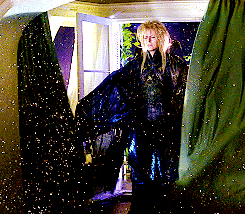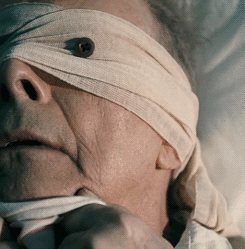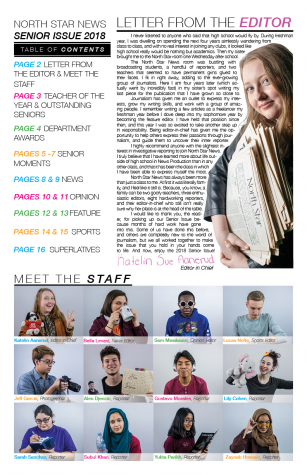Katelin Sue Aanerud
Since 8th grade, I have dreamed of incorporating writing into my everyday life. I also wanted to apply my skills to more classes than just English. When my sister, Darby, told me about her amazing experience working on North Star News, I knew that this would be the place for me. I came in knowing a lot about writing, but not much about journalism. I hadn’t taken the class, and since I was a freelancer during my freshmen year, I went straight into the class my sophomore year. I was assigned to the position of Feature Editor and Social Media Director. Both positions really fit my strengths and my interests. During the year I wrote primarily for the feature section, while dabbling in both news and opinion. I started with only a basic knowledge of journalism, and now I have completely fallen in love with the art. My writing and grammar have drastically improved along with my vocabulary.
Going into the first semester of my senior year, I felt prepared and eager to dive into new things. I knew things would be a lot different this time around as I took up my new postion as Editor In Chief, but I was just as excited as I was nervous. Following in the footsteps of Ben Lipka, I knew the expectations would be high. We had returning reporters that I had grown close to, and I knew they would also have to deal with the dramatic shift in the class’s vibe. I wanted to keep the same strengths, but work on bringing the class closer together, and making it seem more like a class than a study hall. I’ve always felt that the class is very chill, and that has its pros and cons. Last year, Lipka was more lenient on publishing dates and deadlines. That was the main thing I wanted to change coming into the position, and I feel like I have succeeded.
As my last year on staff comes to a close, I wanted everyone to feel like they were part of something special. I wanted to have brought together friends, and formed a family. North Star has been my main passion in my high school career and I love seeing other students fall in love with journalism like I have. I think I have succeeded and I couldn’t be more happy. Next year I will be attending Illinois State University, and taking part in their Journalism program. I hope to reach the same status that I have in North Star, while expanding into radio and communications.
The following are some of my stories and briefs that either took a long time to write, I struggled with, or I am just overall very proud of.

Just a song before he goes: Graham Nash comes to Chicago
Riding the bus to school everyday becomes so routine that I can start listening to Pink Floyd or Tom Petty and drift off into a sleepy haze … until we pull up to Golf. Either my bus misses the light and we wait there for what seems like forever, or we make it smoothly through and I get ready for my school day. One day we seemed to sit there for longer than usual and I let my gaze wander out the window and to the rotating list of artists set to perform at The North Shore Center. And, for once, I recognized a name: Graham Nash. Two time Rock And Roll Hall of Fame inductee Graham William Nash was coming to my town.
He wasn’t necessarily a common name around my house or anything, but after years of listening to wXRT and The Drive on car rides up into Wisconsin I had memorized the lyrics to “Ohio,” “Our House,” and “Suite: Judy Blue Eyes.” Nash’s voice, along with Stephen Stills, David Crosby, and Neil Young have been imprinted in my mind for as long as I can remember. Those harmonies were something I could never get out of my head.
It wasn’t long after I saw the sign that I got into him as a solo artist. And, it wasn’t long after that that I had my face buried in a copy of his autobiography Wild Tales, had a DJ promo edition of his first solo album Songs For Beginners permanently resting on my turntable, and had changed my phone background to a flattering shot of him from 1971 … it was safe to say that I was in love. Too bad that it’s no longer 1971, and that he’s now 76. Still, I consider myself a very determined girl, so I needed to see the legend in concert.
Turns out on March 17 at 8 p.m., I got to see him. From the very back row, mind you, but I was still seeing him. And my eyes never left the stage. Despite his age, every note was held out, his high pitched harmonies were spot on, and he still had a full head of hair. Not the long haired, youthful guitar god that adorned my walls and record collection, but it was good enough!
He ran briskly through the few first songs, which included “Bus Stop,” his hit with British Invasion group The Hollies, “Immigration Man” accompanied by an amusing story about his troubles with American airports, and his newer track “Myself At Last.” He soon got around to playing my favorite Crosby, Stills & Nash song “Marrakesh Express” and then a surprising rendition of his solo song, “Right Between The Eyes.” He threw in a few more songs from the 1970 album Déjà vu, including a thoughtful performance of “4 + 20.”
He closed the first half of the show with a cover of The Beatles’ “A Day In The Life,” and for the first time in an hour I got the chance to take a breath. I reached into my purse and remembered the 8track I had stored in there, along with a Sharpie, in case I got the chance to meet my idol face to face. I was having such a good time that I didn’t bother getting my hopes up about him gracing the vintage copy of Wild Tales.
The second half of the show was filled with stories and hits from another generation. He played “Just A Song Before I go,” “Mississippi Burning,” and a medley of “On a Carousel” and “Carrie Anne.” Again, Nash, along with this guitarist Shane Fontayne and other accompaniment, had my eyes glued permanently to the stage for the remainder of the set.
Other highlights included “Our House” in dedication to Joni Mitchell, an amazing cover of Buddy Holly’s “Everyday,” and a truly heart wrenching, but inspiring, rendition of “Chicago.” He came out once more for one final song, “Teach You Children.” The entire crowd was singing along, and even if he couldn’t hear me from the back row I was too. I thought about the lyrics the entire time, and all of the people in my life that it relates to. I realized every song he performed had a message, and they were all so moving.
I walked out in a daze, heart still fluttering a little bit as I could feel the 8track fumbling around in my fringe purse. I turned to my mom, and before we could leave the parking lot, we had circled around towards the back entrance. And there it was. Their tour bus.
I had already jumped out of the car before my mom parked and I was just in time to run into Fontayne. I showed him my 8track and his eyes went wide. He told me he would check inside and see if the man himself was already resting in the bus. He came out a few minutes later and approached me once more. He asked for my name in a hushed tone and took the piece of music history with him and back into the bus.
I’ll never forget that concert, because of all of the rock stars left, Nash is one of the most genuine. I know this because in his book he talks about meeting his idols, The Everly Brothers, and that ever since he stops to talk to fans. Fontayne stepped back out and handed me the tape, and I couldn’t help but throw my arms around him.
Music is an everlasting form of art, and Nash has never steered away from the controversial side of things. “Ohio” was written about the tragedy at Kent State. “Mississippi Burning” was written is response to the KKK murdering three college students in 1964. He even twisted the lyrics of “Military Madness” and “Chicago” on the spot to reflect his attitude towards America’s political situation.
I’ll never forget that concert, because it made me consider the future of music. No matter what it sounds like, people will always get their message out through this everlasting form of art.
“Very strange ethereal sounds”: A look into Pink Floyd’s Early Years
From psychedelic light shows and interpretive dancers, to the dark past of how Pink Floyd threw their founder to the curb, the band is a lot more than the iconic Dark Side of The Moon album cover. They have a past that has finally been fleshed out by the release of newly discovered material.
On Nov 11, Pink Floyd officially released an extensive collection of media titled The Early Years, ranging from the 1967 to 1972, and covering many platforms. The collection contains never before heard songs, long lost interviews and live performances, recreations of the band’s singles on 7″ vinyl, and reprinted gig posters.The collection covers all their albums and singles that came out before 1972, and includes both original versions of the albums along with new remixes from the original tracks, remastered songs, and live versions of many of the tracks. It follows the band from their start with original vocalist and writer Roger “Syd” Barrett on their 1967 release The Piper at the Gates of Dawn, up to the addition of guitarist David Gilmour and Meddle reaching platinum.
The array of materials in the set is astounding, but so is the price. The full set is $550 on the official Pink Floyd website. For many fans, this is a chance to get a peek at the band’s early start, and for others it’s a burden; they don’t want to hear about the mystical sounds of the pre-Dark Side of The Moon Pink Floyd, or about the strange character that was Barrett. For more casual fans, a version of the highlights from the box set was also released on a two CD set, called Cre/ation, as well as for digital download and is now available on the streaming service Spotify.
Cre/ation is a wonderful gathering of some of the material on the entire box set, and does a good job of showcasing each piece of their history. The beginning is mostly some from the Barrett era, and hearing his vocals on the unreleased verses of “Matilda Mother”, which I hadn’t even known existed beforehand, was a great surprise. It gives a glimpse into Barrett’s creative style that the band hardly let shine through on their albums. The BBC Radio Session version of “Flaming” was also a great addition, because again it’s rare to hear Barrett performing with the band, especially in a live setting.They suddenly go out of order and skip the soundtrack to More, and move onto the half-studio half-live album Ummagumma with two live versions of the tracks off the studio side of the album, Grantchester Meadows, and Cymbaline. Both are relatively short songs and add a brief look at that album. It was the right amount and it was a good choice not to include any of the parts to “Sysyphus” or Roger Water’s track “Several Species of Small Furry Animals Gathered Together in a Cave and Grooving with a Pict”, both of which are very weak tracks in the Pink Floyd discography.
Then, they finally revisit the More soundtrack with the melodic tune “Green is the Colour” with Gilmour on vocals and Rick Wright’s piano much more prominent than in the original version of the song. This was a great choice, though I would have really loved to see a different version of “The Nile Song”, which is considered one of their most rock ‘n roll feeling tune from the early years.
For the second time on the album, “Careful With That Axe, Eugene” and “Embryo” appear. It’s rather redundant and though the complete boxset does this many more times, these tracks aren’t important ones in the band’s history and I would have rather seen an extra version of something from a little earlier, like the previously unreleased “Scream Thy Last Scream” or “Vegetable Man”.One of the highlights of this collection is them actually including tracks from the 1970 cult classic Zabriskie Point, in which had many psychedelic bands teaming up to create an outstanding soundtrack to an absurd film. Pink Floyd is joined by Jerry Garcia, of the Grateful Dead, and Roy Orbison. Out of the five tracks, “The Riot Scene” is my favorite. Right from the start, I knew it sounded familiar. This song was composed by Wright, and would later turn into “Us and Them”, which is part of Dark Side of The Moon.
Following the soundtrack there is the title track from Atom Heart Mother, performed live at Montreux in 1970. There is a brief opening by Waters, and the band then goes into a much more upbeat version of their 23 minute long song, and shortened it down to only 16 minutes. With all of the choir parts taken out of it, it sounds like a completely different song and I enjoyed it more than the studio version. There were shorter pauses between the parts and gave it an overall more Meddle feel.
Many would agree that Meddle is really the turning point of the band, and moreso the complete second side of the album titled “Echoes”. It’s an astounding track by itself and complete immerses the listener in an array of sounds. “Nothing, Pt. 14”, or “Echoes Work in Progress” gives fans a chance to hear the rough draft of a fan favorite.One of my all time favorite Pink Floyd albums is Obscured By Clouds. It was based off the soundtrack they did for a french film titled La Vallee, and there are a total of three tracks on Cre/ation that were originally on the album. “Childhood’s End” is an amazing representation of the band before Dark Side of The Moon, both with the style of Gilmour’s singing, and the high pitched guitar solos. In this remix, Waters’ bass is brought out more, and a steady ticking was added into the background. The fade of the song is also lengthen with the addition of another few beats. This song has always been high up on the list of my favorites, and the changes suit the song and the style of the band at that period.
“Free Four”, also off Obscured By Clouds, is a far more upbeat song with a darker message. This is one of the few songs in their earlier years sung by Waters and was a great choice to be added. I think this track would also appeal to new fans because of how simple the beat is, opposed to the intense timing and rhythm of many of their instrumental tunes.The last track on the album is “Stay”, and it’s a soft and very nice closing to the entire album as a whole. This is also the last track on Obscured by Clouds, and therefore the last song released before Dark Side of The Moon. This really ties together the time period as a whole.
Cre/ation is a nice spot light on Pink Floyd’s early years, but the box set as a whole is even better. The collection is outstanding and really displays the diversity of this legendary band.

The Stars Look Very Different Today
The news came as a surprise to most people, seeing the rockstar only just celebrated the release of his twenty-fifth album and his sixty ninth birthday last friday, but after an official statement from David Bowie’s, Duncan Jones, we knew Bowie has joined the great gig in the sky.
“Very sorry and sad to say it’s true. I’ll be offline for awhile. Love to all. ” Jones tweeted out late Sunday night, accompanied by the photo to the left.
The rockstar, formally known as David Jones, first hit it big with the song “Space Oddity” released on his first album and as a single in the summer of 1969. This song solidified his first persona of many, Major Tom. The astronaut is often referred to in other pieces of his later in his career and is also commonly referenced in popular media with the repeated phrase “Ground control to Major Tom”. The music video that accompanied the song would also be one of the many Bowie would record and act in.
The next three albums following his self titled album were soon to become huge hits. The Man Who Sold The World pictured Bowie in a dress on the cover, and is the point where he began to break through into the fashion world, and confuse many with his alien-like ora and his blend of genders.The next album was Hunky Dory, which brought the world into a new Bowie as he sang “Changes” and “Oh, You Pretty Things!” and many of the album’s songs became instant classics. All that was left is to form himself into something different. Ziggy Stardust came along soon after with his hit record “The Rise and Fall Of Ziggy Stardust and The Spiders From Mars” which illustrated the life of a “Starman” and his adventures down to Earth.
From then on, Bowie kept the persona of Ziggy Stardust through the album Aladdin Sane, where he wore his famous lightening bolt that would forever be the symbol for the man. It wouldn’t be until he donned the new character of Halloween Jack, as portrayed on his 1974 album Diamond Dogs, that fans realised that he would never stay the same for a long period of time. Bowie would transform once again into The Thin White Duke for albums such as Young Americans, Station To Station, and Heros.
Before the release of the first album in the “Berlin Trilogy”, Low, Bowie would move back to his roots in acting and starred in the cult film The Man Who Fell To Earth as T.J. Newton, an alien sent down to Earth much like Bowie himself. This wouldn’t be the only movie he starred in in his career, and after the release of Let’s Dance, he went back once again to star in Merry Christmas Mr.Lawrence, The Hunger, and Labyrinth. The Jim Henson film Labyrinth has since become a staple of the rockstar as he danced around his puppets covered in glitter.
He experimented later in the 90’s with strange instruments and moved onto a more jazzy side with records like Black Tie White Noise, Outside, and Heathen. Only recently, 2013, did Bowie move back into rock and roll with the surprise album “The Next Day”, after ten years of silence.Sometime during the recording of the album, Bowie was officially diagnosed with lung cancer, which would take his life after the release of Blackstar.
Between his strange roles in many cult films, his outstanding lyrics, and his overall appearance and fashion, Bowie has become a pop icon. Fans all over the world are mourning his death with celebrations of his life.
“Look up here, I’m in heaven. I’ve got scars that can’t be seen. I’ve got drama, can’t be stolen. Everybody knows me now.” Sang Bowie on his new album, two days before his passing. Those close to him knew it was coming, and that last album was a gift to all his fans.David “Bowie” Jones has traveled back home, to his star somewhere in a far off galaxy, but he will not be forgotten.

Major Tom Lands On A Blackstar
Two years since the release of David Bowie’s comeback album The Next Day, Bowie came back with a new look, aesthetic, and outstanding album on his sixty ninth birthday, Jan. 8.
I was super excited for the new release, as this would be the first studio album of his that I could listen to the day it came out. I’ve been a fan since I was very young, but only in the last two years, right after The Next Day, did I fall head first for his range of styles and music.
This album now means even more to me, after his sudden passing, and the songs display an even more powerful message after the events of Sunday night.
The opening song, and title track “Blackstar”, is a ten minute story and is accompanied by his eerily beautiful voice and pounding beat. The song and music video both tell the continued story of his first character, Major Tom. Major Tom was originally an astronaut in the song “Space Oddity”, and then he was revealed to be a “junkie” in the 1980 classic “Ashes To Ashes”. The story was added to with the Remix version of “Hallo Spaceboy” by The Pet Shop Boys. “Blackstar” continues the series, showing the aftermath of “Space Oddity” and him advancing to the roll of a god like figure after his death. Given the background, this song is one of my favorites on the album. It shines a new light on Bowie’s abilities and lengths he’s willing to go to show who he is.
The second song is a slightly altered version of the B-Side to his 2014 single “Sue (Or In The Season Of Crime)”. “‘Tis A Pity She Was…” is a song with a heavy beat, unlike the original release. In my opinion, the original working of the song was better, though it never has officially appeared on any of his albums besides the Record Store Day exclusive 45’.
While also working on the music for a musical adaptation of the 1976 cult film The Man Who Fell To Earth, which was his first feature film, he recorded one of the songs. “Lazarus” gave the album a whole new meaning after the passing of Bowie. With lines such as “Look up here, I’m in Heaven”, it’s hard to dismiss the song as anything but a final clue to his fans. He continues the song with “Look up here, I’m in danger”, and it sends chills down your spine. Though it’s not my favorite song on the album, the emotion put in this song is remarkable and will surely not be tossed to the side with some his other recent tracks.
Like “Tis A Pity She Was…”, “Sue (Or In The Season Of Crime)” was a track that Bowie had previously released, and was reworked for this album. “Sue” was put on his latest compilation album, “Nothing Has Changed”, assuming it would be one of his new hits. The story of a man and his crumbling relationship with his wife is certainly heart wrenching, but one of his best? I would disagree.
“Girl Loves Me” has to the most different of the songs and sort of sticks out like a sore thumb with the rest of the overall chill album. Combining a wide range of slang, known as Nadsat, and extensive swearing, this is Bowie’s shout out to a book he has notoriously claimed to be his favorite: A Clockwork Orange. I have to say, though this song is different and almost pop-like, I really enjoyed it. It’s been overlooked in most other reviews, but I think this deserves a spot in a best of album, hopefully taking the place of “Sue”.
The last two songs blend so well together that I can hardly think of them as two separate songs. “Dollar Days” and “I Can’t Give Everything Away” are, next to the title track, the best part of this album. “Dollar Days” has a very steady beat and is impossible to get out of your head. I loved it the first time I heard it. Out of the entire album, I would have to say “I Can’t Give Everything Away” is the best song, and a great way to end Bowie’s long legacy. Slipping in a harmonica part and moving lyrics, this song sounds like something off his album Low. By far my favorite line would have to be “Seeing more and feeling less. Saying no but meaning yes. This is all I ever meant; This is the message that I sent.” With that, Bowie exited and there wouldn’t have been a stronger parting message from him.

NSN Audio Story: Switching tracks
Inspired by NPR’s StoryCorps and to capture the spirit of Thanksgiving, the North Star News staff created several audio stories framed around this question: “What was a moment or event in your life that at the time seemed small, but ended up having a large impact or effect on you later in your life?” The staff sought people of different generations and crafted these pieces.
When life takes you to unexpected places, the only thing you can do is make the best of a situation. Penny moved into a new town at a young age, and met a group of girls that would send her life in a new direction. This chance meeting made her record skip tracks, playing a new and very different tune.
What’s it gonna be then, eh? : A Clockwork Orange’s relationship with the audience and being banned
In honor of Banned Book Week being celebrated around the world, and in our own library, I bring to the table one of the most controversial books to ever be written: Anthony Burgess’ A Clockwork Orange.
Written in 1962, and set in the vague future, A Clockwork Orange is narrated from the perspective of a young boy as he goes through his teenage years. He isn’t quite like any teenager nowadays, however. His day starts off with excuses for him to stay home from school, to which his clueless mother calls him in sick. As soon as his parents leave, he does as well. He’s decked out in the height of fashion, and matched his fellow “droogies”, or gang members. The antics the group got up to following the dimming of the sun were deemed too “violent” and “sexual” for many schools and libraries in the United States, and England.
The whole book is filled heavily with “Nadsat”, a term developed by Burgess for the strange slang Alex, the main character, and his droogies use throughout the book. Being a gang, and involved in robbing, theft, rape, and, later in the novel, accidental murder, it’s clear why this book has been banned and challenged over and over again. Most of the spark from this book came after the release of 1971 film of the same same, directed by Stanley Kubrick, with Malcolm Mcdowell in the role of Alex.
While there are many difference between the novel and movie, the main being that the film was incredibly dulled down in comparison to the violence displayed in the book, both have had a serious and dark history. Kubrick filmed and released the movie before the original last chapter was included in a third edition of the novel.
After being caught by the police, and framed by his other gang members, Alex in sent to prison, and later tested on to see if he could be “cured” of his criminal ways. Alex is taught to respond to images of violence and sex with becoming repulsed, sick, and vomiting. With this the government displaces him, until he is driven to madness and makes an attempt to end his own life. THis didn’t succeed, and neither did his “treatment” in the long run. It wears off and in the final lines of the original novel he makes this remark: “And there was the slow movement and the lovely last singing movement still to come. I was cured all right.”
This novel challenges the ideas of nature vs nurture, and whether Alex was born evil or if he could be changed, and if he could be changed, was it already too late? After reading multiple times, Burgess is clearly saying that no one can change by an outside force. They need to change themselves; no torture or pure pressure can alter a person without them accepting it. He says that there is always a way to combat outside forces and remain who you are. Of course, for some people this would mean staying true to yourself and staying home to study instead of going out partying, but in Alex’s case it was him staying this rotten human being.
Later on, Burgess added another chapter that has Alex meeting one of his old gang members and seeing him grown up, and having a family, while he was still involved in crime. It’s this slight encounter that leaves Alex stunned. He sees that someone like him could change and possibly have a good life. “I knew what was happening, O’ my brothers. I was like growing up. Yes yes yes, there it was. Youth must go, ah yes. But youth is only being in a way like it might be an animal.”
The addition of the last chapter may not excuse the rest of the horrible actions of Alex and his droogs in the novel, but I believe it should have at least given viewers a chance to see the character in a new light, and maybe not challenge this as a banned book for the same reasons. Sure, the language and actions of the gang is not excusable, but i also think many people want it banned for the fact that it glorifies Alex’s actions. In the end, he flat out says that the things he did were wrong and I believe that added a lot to the overall perception of the main character.
Beautiful in blood and gore
Graphics for Senior Issue 2017 and Layout for Senior Issue 2016











